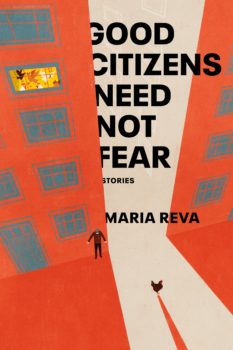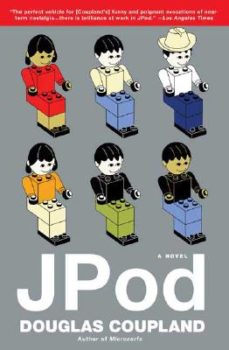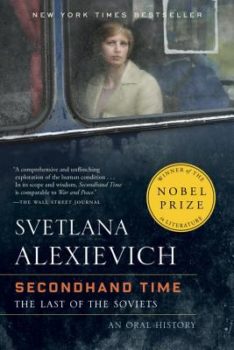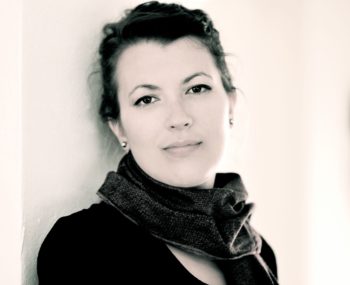 |
| Maria Reva |
Between Humor and Darkness: An Interview with Maria Reva
"Everything started from a lunchtime conversation with my parents, randomly talking about our old building in Ukraine": Maria Reva talks with Isaac Yuen about her debut collection, Good Citizens Need Not Fear, which takes place in the pre- and post-fall USSR.
March 12, 2020
Born in Ukraine and raised in Vancouver, Canada, Maria Reva received her MFA from the Michener Center for Writers at the University of Texas. Her stories have appeared in The Atlantic, McSweeney’s, Granta, The Journey Prize Stories, The Best American Short Stories, and elsewhere. She won the Writers’ Trust of Canada’s RBC Bronwen Wallace Award in 2018 and a National Magazine Award in 2019. Her linked story collection, Good Citizens Need Not Fear (Doubleday) is out this week.
I first met Maria in 2013 through the Southbank Writers Program, a three-month creative writing intensive offered by Simon Fraser University. We were near the beginning of our writing careers then, but it was soon apparent to me that Maria not only possessed a knack for crafting structurally novel and intricate narratives, but also a tough-mindedness to get the work to where it needs to be, no matter how much work that might take.
Having read various drafts over the years, I relished the chance to sit down with Maria’s polished stories within the context of a linked collection. What I found was not only that same delightful leaning into the odd and absurd, but a level of meticulous craftsmanship shaping each story into an interlocking piece of a one-of-a-kind jigsaw puzzle. Wildly inventive and technically sound, the collection showcases Maria’s M.O. as a writer through and through. We chatted about the historical events and personal anecdotes that inspired these tales over dinner at a Vietnamese restaurant one January evening, on the eve of a rare Vancouver blizzard.
Interview:
Isaac Yuen: One of the earliest workshopping memories I have of you was for a short story called “Subject Winifred” (now published in The Malahat Review). At that time, you were inspired by the work of Joyce Carol Oates, and in particular one story of hers. Can you talk about that?
Maria Reva: The story was called “How I Contemplated the World from the Detroit House of Correction.” It was one of my favourites at the time and was written in the style of a high school English report. In it, the main character details characters and events in her life, deconstructing them into categories; her mind is trying to find logic in happenings that seem to defy logic.
At the same time, I was working on “Subject Winifred,” which was about a girl observing her mother trying to become a breatharian—someone who fasts and believes they can survive on nothing but water and sunlight. For a long time I didn’t know how to structure the story. But then Renée Sarojini Saklikar, our Southbank mentor, suggested that I use the structure of the Joyce Carol Oates story as my muse text, and in the end “Subject Winifred” took the shape of a science report.
That format created such a detached and unsettling feel to the story. How important is form in the formation of your stories nowadays?
I don’t really find the story until I find its form and tone. I usually know what the premise is when I start, but things don’t click into place until I know something about the structure. One of the early stories in Good Citizens Need Not Fear, titled “Little Rabbit,” begins with a diagram depicting how baby beds are arranged in an orphanage. Babies deemed to have less “potential” are hidden away in the middle, and this is based on how people with disabilities were classified in the Soviet Union. It was through these diagrams that I saw how the protagonist, an orphan named Zaya, slipped through the cracks of the system.
The stories in your collection take indirect paths into the emotional lives of the book’s characters, all residing within one key central building. What was the initial germ of your collection, which takes place in the pre and post-fall USSR, and was it planned from the beginning?
 Everything started from a lunchtime conversation with my parents, randomly talking about our old building in Ukraine. My dad told me that during that first winter the heating didn’t turn on, which was strange because everything was centralized and connected. He gave his address to the woman at the town council. She said that there was no such address, and since they didn’t have it in the records, our building didn’t exist. So my dad went on this bureaucratic goose chase, trying to prove our building existed with different government agencies. When he told me this absurd anecdote, I knew I needed to write about it.
Everything started from a lunchtime conversation with my parents, randomly talking about our old building in Ukraine. My dad told me that during that first winter the heating didn’t turn on, which was strange because everything was centralized and connected. He gave his address to the woman at the town council. She said that there was no such address, and since they didn’t have it in the records, our building didn’t exist. So my dad went on this bureaucratic goose chase, trying to prove our building existed with different government agencies. When he told me this absurd anecdote, I knew I needed to write about it.
Wait…this was a real event that happened?
Yes! The story became “Novostroïka,” which literally means “new building.” Once I had it and an early iteration of “The Ermine Coat,” which takes place later on in the post-fall section of the collection, I realized there might be other stories from other tenants living in this building. I thought maybe I’d have a story in the elevator and another story in the garbage chute, and suddenly all these ideas started coming.
There are linkages not only to this building, but also linkages between characters and the stories they keep showing up in. Did you start out with these connections in mind, or did you work recurring characters in later on?
I didn’t have a grand scheme of linkages going into the collection. Most of the connections appeared to me gradually, story by story. For example, I started “Little Rabbit” while I was writing another story called “Miss USSR.” I was exploring the origin story of the protagonist, Zaya. I had written a paragraph about her orphanage, but soon realized that was a story in itself.
A few connections / recurrences arose after the entire collection was written. On a big sheet of paper I mapped the characters, places, and key objects of all nine stories to see which dots could be connected. My editors also offered suggestions. For example, Milena originally appeared only in one story early in the collection called “Letter of Apology.” The wonderful Lee Boudreaux pointed out the abruptness of her disappearance, so I found space for Milena to reappear in “Bone Music,” a story about people making contraband vinyl records from x-ray scans. I replaced the two minor characters with characters who had longer shadows in the collection as a whole. Milena ended up coming back into the fold, and then again in “The Ermine Coat.”
We touched on diagrams as one of the distinguishing features of the collection, but there are also various illustrations and lists scattered throughout. Why did you chose to incorporate these elements into your fiction?
 When I was writing “Novostroïka,” I had the story pretty much done, but it lacked a spark for me. At the same time, I was reading JPod (Bloomsbury, 2006), by Douglas Coupland, a novel about a group of computer programmers working in an office. I would be reading the prose and then the next page would be filled with different kinds of instant noodle flavours this team ate during the week. Turn a few more pages and there’s a scoresheet for who won foosball last week, or the same word repeating over and over again. For me, these kinds of lists or typographical play interacted with the prose in an interesting way; I got a deeper sense of the office environment and a better idea of who these people were. They also highlighted the mundanities of office life, how much time they wasted, the tasty junk they ate.
When I was writing “Novostroïka,” I had the story pretty much done, but it lacked a spark for me. At the same time, I was reading JPod (Bloomsbury, 2006), by Douglas Coupland, a novel about a group of computer programmers working in an office. I would be reading the prose and then the next page would be filled with different kinds of instant noodle flavours this team ate during the week. Turn a few more pages and there’s a scoresheet for who won foosball last week, or the same word repeating over and over again. For me, these kinds of lists or typographical play interacted with the prose in an interesting way; I got a deeper sense of the office environment and a better idea of who these people were. They also highlighted the mundanities of office life, how much time they wasted, the tasty junk they ate.
So after I read JPod, I thought of putting lists like that in “Novostroïka,” to create the effect of a tug-of-war between what the lists are telling you versus how these characters are actually living. The lists are the state-approved version of the Soviet Union—lists of various candies and canned goods—so that when you read these reports you think, wow! So much food and abundance of choice! (While doing research, I found a declassified CIA report on the Soviet canning industry.) But the prose bears witness to the shortages and hardships people faced in real life.
What about the other illustrations, like instructions on how to turn a tire into a swan, or sketches of the central building itself?
I couldn’t describe in words this real thing that people do with tires in Ukraine, where they cut old tires and make any animal you can think of, paint them, and place them all around preschools, daycares, parks. At first I tried to describe the process but it came across like a boring tech manual and took up a lot of space. So I thought I would just illustrate the whole thing.
As for the drawings of the building, it came down to a similar issue. The story that featured them—the last story of the collection—had gone through multiple drafts because readers couldn’t visualize what was happening to the building until I illustrated the… “process.” (I don’t want to give away the ending!)
Going on the journey through this collection, I can feel how each tale walks this tightrope between the comedic and the tragic, the farcical and the deadly serious. Did this balance come naturally to you as you wrote each story, or was it a struggle to find this middle road?
For most stories it came naturally; it might just be the way I was raised. Whenever there was a hard situation my family would find a way to laugh about it. Awful situations are often unusual, and it’s that strangeness that can be humorous. It’s also therapeutic to be able to laugh. So that’s how I generally process the world. I think that’s how many people survived in the Soviet Union when things got dark. I heard that days after Chernobyl happened people were already telling jokes.
No “too soon”?
Never too soon! There was a nuclear power slogan from the government that went something like “An atom of peace in every home” or “A peaceful atom for every home.” After the disaster happened people started repeating the phrase as a joke. “Now we really have a peaceful atom in every home!”
I’m such a fan of the satirical humor that runs through the stories, but my favorite scenes actually contain an abrupt inversion of tone from absurdity to utter tenderness. What was your process of mapping these emotional moments onto your story trajectories?
Those moments are my ways to get to know the characters. When I start a story, I usually start with a premise, and build characters around that premise. Some writers have a sense of their characters when they start a story, and see how the characters act once they are placed together on the page, but I can’t write that way. Instead I start with a premise and then try to figure out what kind of person would do this particular kind of thing. For example, in the last story, “Homecoming,” I had the premise of misery tours—
Wait, that is also a real thing?
 Oh, yes, I read an interview in Secondhand Time (Random House, 2016; first published in Russia in 2013), by Svetlana Alexievich, that mentioned there were agencies where oligarchs can sign up to be homeless for a day, or be mock-tortured as political dissidents—of course, their bodyguards are around the corner should anything happen. The question that came to mind after deciding to write about this was what kind of people would get involved with this? So characters usually arrive through premises for me, and when I write a story it’s emotionally spare. That’s one of the challenges for me when I write; I focus so much on the puzzle of the plot that sometimes character motivations are murky. It’s like I have the skeleton of a story, and then I have to fill in the emotional meat. I think those moments of tenderness you mentioned are my way of fleshing out the people, to find answers on why they’re doing what they’re doing.
Oh, yes, I read an interview in Secondhand Time (Random House, 2016; first published in Russia in 2013), by Svetlana Alexievich, that mentioned there were agencies where oligarchs can sign up to be homeless for a day, or be mock-tortured as political dissidents—of course, their bodyguards are around the corner should anything happen. The question that came to mind after deciding to write about this was what kind of people would get involved with this? So characters usually arrive through premises for me, and when I write a story it’s emotionally spare. That’s one of the challenges for me when I write; I focus so much on the puzzle of the plot that sometimes character motivations are murky. It’s like I have the skeleton of a story, and then I have to fill in the emotional meat. I think those moments of tenderness you mentioned are my way of fleshing out the people, to find answers on why they’re doing what they’re doing.
Filling in the emotional meat—I love that image so much. Was it difficult to incorporate these big tonal shifts on a mechanical level?
So I said that the balance between humor and darkness usually came naturally for me, but conveying these elements in a story was sometimes tricky. “Little Rabbit,” for example, gave me a lot of grief. It’s a story where the most atrocious things are happening: children are basically written off by society in this orphanage, waiting to die. When I first wrote the first iteration, I wrote it straight, depicting the atrocity head-on. The story just didn’t work, maybe because the subject matter is so horrific. It felt like staring into the sun. But once I found the tone, which I would describe as off-kilter, it clicked. I suddenly wasn’t looking at the sun anymore, but at a point beside it. The story took on the institution’s perspective and how it was trying to charm the reader into the logic of why the children had to be kept this way…
So the reader would buy in.
Exactly! You see why the state would expend more resources on children whom they deem to have more potential. Then, from that point of view, the story started to roll and by the time it fully shifts into Zaya’s point of view, you see what kind of world this is and what she needs to do to survive in it. This approach helps the reader make their own conclusions about this place without being told directly. I think it’s more powerful when the reader makes their own conclusions instead of the author telling them that this certain thing is tragic and that they should feel a certain way. I often get suspicious when an author is trying to tell me how to feel.
I know this collection occurs in pre- and post-fall USSR, but I’m still constantly amazed that so much in these stories are grounded in real events. How much was based on personal memories of growing up there?
I was born during the fall, so my own memories were mostly of times afterwards, the chaos that followed—the currency swings, how my parents were no longer being paid at their jobs but had to keep working because the apartment was tied to my dad’s job, how they had to make fur coats to get by; that was the basis of “The Ermine Coat”. Yes, an engineer and a chemist making fur coats by candlelight to make money because the electricity would get turned off. It was a crazy situation.
 The pre-fall stories came more out of older memories from family members and from the research I did of that time. In terms of writing about the two eras, I wanted to show how much had changed and also, how little had changed. People went from living in one brutal system to another brutal system. Having grown up mostly in North America, I was also trying to understand Soviet nostalgia, what things were easier in the old days, because there were a lot of things that were easier. More was determined for you and you didn’t have as many choices, but in a way that made things simpler. Your life was more planned out, you didn’t have to worry about job security, and there was free daycare.
The pre-fall stories came more out of older memories from family members and from the research I did of that time. In terms of writing about the two eras, I wanted to show how much had changed and also, how little had changed. People went from living in one brutal system to another brutal system. Having grown up mostly in North America, I was also trying to understand Soviet nostalgia, what things were easier in the old days, because there were a lot of things that were easier. More was determined for you and you didn’t have as many choices, but in a way that made things simpler. Your life was more planned out, you didn’t have to worry about job security, and there was free daycare.
I know that your next project is a novel. Can you share a bit about that?
I’m currently working on a novel set partly in modern-day Ukraine, and partly in Texas where I’ve lived for the past four years. I’ve been itching to write about Texas.
Are there lessons working on your collection that you think will translate over to your novel?
I think writing Good Citizens Need Not Fear taught me to pivot a lot faster when I know something isn’t working. I used to dwell on plot and story trajectories that weren’t working for too long, and be precious about changing things. Now I’m more willing to take things apart and put them back together over and over again until something fits. Writing this first book has taught me to be more ruthless in the revision process.
ISAAC YUEN
Isaac Yuen’s short fiction and personal essays have appeared in Newfound, Orion, Tahoma Literary Review, Tin House, Shenandoah, and elsewhere. He was a 2019 Jan Michalski Foundation nature writer-in-residence in Montricher, Switzerland, and currently lives in Vancouver, Canada, on unceded Coast Salish territory.


No comments:
Post a Comment